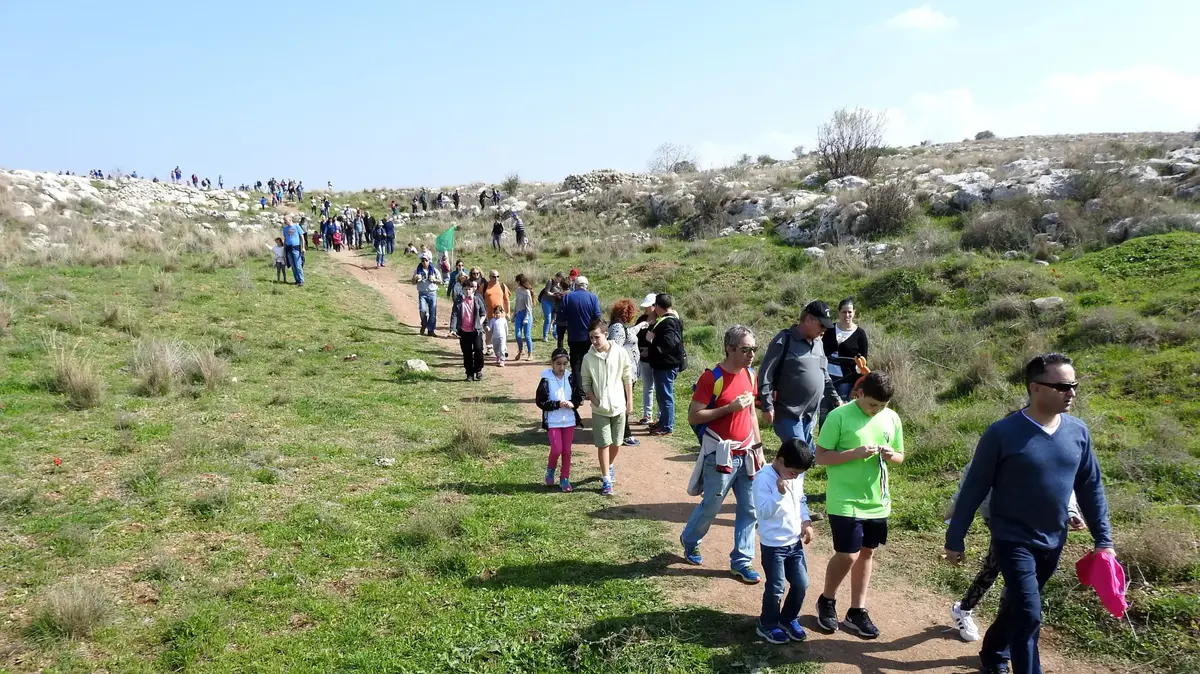Cheese factories, honey shops, wineries, ecological salt mines
.
Artisans who have been making their products for decades in the Navarrese valleys of
Yerri
and
Guesálaz
offer guided tours, tastings and tourist proposals so that their work, their environment, their culture and their way of life are known.
They nurture the eco-experiences program of the
Tierras de Iranzu
association
- made up of 40 towns, 5 municipalities and more than 90 agrotourism companies in Navarra -, determined that visitors not only see but also experience this territory located in the center of the community statutory.
A dip in ethnography that, for example, takes the traveler to
the Henri Lenaerts Center
, the Belgian artist's house in the town of Irurre converted into a museum, where a wonderful garden full of bronze statues and
mindfulness,
meditation and yoga
activities await
on the top floor.
And the next day he invites you to get on a
pick up
van
to go on a safari through the holm oak woods of the
La Tejería
farm
of the Alba Reta cattle ranch
, in the Grocin mountains, where Miguel Reta recovers the Navarrese wild breed and you can be in direct contact with his cows in the pastures of the Yerri valley.
Tierras de Iranzu, an enclave near Pamplona and Estella, is a peaceful place to enjoy rural plans where nature and social distancing are guaranteed, perfect in these times of coronavirus.
The cloister of the monastery of Santa María de Iranzu.
pablo lasaosa
Goblins next to the monastery
The lamia flirts with a stocky gentleman next to a fountain, while, a few meters further on, two
sorguiñas
(witches) gather herbs, a
galtxagorri
(elf or genie)
lounges
on a tree branch, two chickadees argue, the Basajaun it comes out of the frond surprising the walkers and the one-eyed Tartalo scares the children.
It is the
Magic Forest
, a theatrical visit with characters from Navarre mythology that takes place every Sunday morning, until October 18, with a coven as the end of the party.
It runs through the canyon of the Iranzu River, a charming path, easy to do, a transition between the Mediterranean landscape dominated by the vineyards of the south of the region and the imposing beech forests, with an Atlantic climate, that climb, to the north, the
Urbasa natural park and Andía
.
A path that is well worth a walk, whether it is among friendly mythological creatures or without them.
enlarge photo One of the scenes of the Magic Forest, a theatrical experience with characters from Navarre mythology.
PABLO LASAOSA
Beech, maples, oaks, holm oaks, thorns;
Egyptian vultures, hawks and bearded vultures flying over a gray sky dripping sirimiri.
The four-kilometer route (round trip) begins and ends next to the imposing
monastery of Santa María de Iranzu
, founded by Benedictines in the 11th century, enlarged by Cistercians between the 12th and 14th centuries and currently home to a community of parents Teatinos that organizes guided tours: from the hermitage of San Adrián - the oldest part - to its monumental kitchen, passing through the cloister or the punishment cells, where the monks who dared evil acts such as washing in the river ended up (they could only do it in the
lavatorium,
hands, feet, and face).
So many places to stay as inhabitants
The monastery inn, with 150 beds available for those seeking the greatest silence, is an example of how Tierras de Iranzu is filled with unique accommodations where sleeping can also be an experience.
Palaces and mansions converted into rural houses, mostly for full rental, although there are some that offer rooms, such as the
rural accommodation Casa Baquedano
, in Murugarren: three exquisitely restored 16th-century floors, with a coat of arms on their façade.
Along with the three
campsites,
two hostels and several hostels add up to 3,000 places, as many as there are inhabitants of the area.
A sailing boat in the Alloz reservoir (Navarra).
PABLO LASAOSA
An inland Cantabrian
The region has been a traditional destination for walkers, nature lovers and active tourism practitioners.
This is demonstrated by the 18 hiking routes that cross the territory, the fame of the town of Eraul as the epicenter of initiation to climbing or the 30 years of experience in teaching trialbici at the
Trialbici Ros School
(656 90 84 58), located next to the monastery of Iranzu.
Visitors also discovered this covid summer marked by nearby trips the two bathing areas of the
Alloz reservoir
, which for the next one is more than likely to show a blue flag.
So much so that its capacity had to be regulated.
Its turquoise and saline waters, coming from the Salado and Ubagua rivers, shine between the valleys of Yerri and Guesálaz, bite with a north wind that enters in the afternoon and offer optimal conditions for
windsurfing and sailing
.
Around here they call it the “Cantabrian inland” or the “Costa Azul de Navarra”.
The reservoir is the headquarters of the
Navarra de Vela School
, which also offers a baptism in
paddle surfing
and rental of canoes and pedal boats.
Of course, until the water level drops so much that you have to put your gear away and wait for the following spring to arrive.
enlarge photo Beehive of the Eztitsu Mielería, in Lorca (Navarra).
pablo lasaosa
From the beehive to the vineyard
In 2007 or 2008, this little-known piece of Navarra received some 50,000 or 60,000 visitors a year, according to calculations, by eye (because there was nothing quantified), Charo Apesteguía, manager of the Tierras de Iranzu association.
This year it will have far exceeded, and only in summer, the 300,000.
The eco-experiences, which offer the public very traditional activities, are those that, in his opinion, attract tourists, fix the local population, since young people see a future for their parents' trade, and are creating new businesses.
Like the
Eztitsu Mielería
, in Lorca (where the Camino de Santiago passes), which offers different beekeeping experiences and opened 10 days before the confinement decreed last March.
Honeys serving in the tasting
of
rosemary
(which is harvested in April),
the thousand flowers
(early summer),
bramble
(August) or
sap
(honeydew, black) have a more intense flavor after of having known closely, in the field, the hives and their threats, wearing the equipment of a real beekeeper.
Tour of the vineyards of the Lezaún winery.
PABLO LASAOSA
There are two other honey shops,
Gorena
and
La Sacristana
, which are part of the association.
And three wine cellars,
Aroa
—with its avant-garde restaurant standing out on the top of Mount Apalaz—,
Tandem
and
Lezaún
.
“We had to do something to enhance our vineyards, which cannot be seen from the winery,” explains Edorta Lezaún from the box of a cart pulled by two Breton mares with which he organizes field visits.
It is a highly demanded activity that includes an outdoor organic wine tasting and finds a different landscape depending on the time of year.
During the walk at the end of September, the vines set out with bunches of tempranillo, garnacha, graciano grapes;
it is harvest and harvest time.
In two or three weeks, these fields will experience their particular autumn, with the leaves of the Graciano variety turning yellow, and those of Tempranillo reddish.
Eat and drink from kilometer zero
The
grill Lezaún
adjacent its hold on the rock, the oldest Iranzu Land XVIII century, puts a
lot of
kilometer zero
on your table.
For example, colt steak from
Finca Sarbil,
in Etxauri, where horses, cows and chickens are raised, following ecological criteria (it can also be visited).
The
Etxesakan cider house
, in Garisoain, less than three kilometers from the Alloz reservoir, is the only one in the area that is open all year (the high season for cider lasts from January to May);
It is accompanied by its fermented apple drink with cider chorizo, lamb ribs, ribeye, Idiazábal cheese with quince, walnuts and curd.
Here it is easy to see a local brand of honey in a curd;
and cheeses and wines from neighboring towns pairing in good harmony.
The production of
Idiazábal cheeses
,
gazta zaharra
(cream of old cheese) or curd with
latxa
sheep's milk
is another resource that has opened a window to tourism.
"We consider it as complementary activities," says Mari Mar Castro, from
Quesería Urrizaga
- with several awards for the best shepherd's cheese in Navarra - who 20 years ago left the computer in Pamplona, where she worked as a computer, for the milking machine in Abárzuza .
From November to July, the time of the bulk of the production, she and her husband, Miguel Iriarte, dedicate themselves to their own business and hardly receive an audience;
in summer and part of autumn they intensify their guided tours (948 52 01 09) and their tastings, and they talk to their
guests
about how they make their cheeses with the same passion that they use in making them.
There is an added value in the fact that whoever comments on the dishes and serves the shepherd's menu - crumbs, sheep's chorizo or lamb stew - at the two tables with benches running from the borda (shepherd's house) that the
Aldaia Cheese Factory
has In the Sierra Andía, the only business within the natural park, is Mirentxu San Martín, one of the owners.
Or in that it is María Teresa Arizaleta, fifth generation making the
artisan pacharán of Bodegas Azanza
, who details how the aniseed should be in which the sloes are macerated, leading the guided tour of the winery and the fields where they are grown and harvested.
The pools of the Gironés salt mine.
PABLO LASAOSA
Spring salt
220 million years ago, the surroundings of the town of
Salinas de Oro
, in the Guesálaz valley, was covered by the immense
sea of Tethys
which, when evaporating, left behind a diapir or thick layer of salts at about 3,000 meters deep.
The underground waters return them to the surface in the form of natural springs that feed two salt mines in the area,
Nuin Eraso
and
Gironés
.
Gregorio Gironés puts it in context as he prepares.
Rain boots,
txapela,
neck scarf and short sleeves on a cold morning.
It takes a kind of rake and leads the water from one era to another (pools with very little depth) of which are juxtaposed in
its facilities
.
The sun and the wind will do the rest, evaporating the water and leaving an ecological salt, very white, shiny for all the mineral it contains - iodine, magnesium, iron, calcium - and, according to Gironés, healthier, as it contains less sodium.
Visitors can go to work to experience this artisan process and learn how the flower of salt (caviar from salts) is obtained or how innovative products are made: salt in wine, with Provencal herbs or with pepper.
"Those are the children's things," says Gregorio.
Next generation, assured.
Find inspiration for your next trips on our Facebook and Twitter and Instragram or subscribe here to the El Viajero Newsletter.







/cloudfront-eu-central-1.images.arcpublishing.com/prisa/ZAKACA3UB5CRPJK2EPZ4WKC62Q.jpg)

